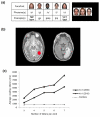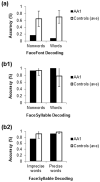Reading faces: investigating the use of a novel face-based orthography in acquired alexia
- PMID: 24463310
- PMCID: PMC4058438
- DOI: 10.1016/j.bandl.2013.11.005
Reading faces: investigating the use of a novel face-based orthography in acquired alexia
Abstract
Skilled visual word recognition is thought to rely upon a particular region within the left fusiform gyrus, the visual word form area (VWFA). We investigated whether an individual (AA1) with pure alexia resulting from acquired damage to the VWFA territory could learn an alphabetic "FaceFont" orthography, in which faces rather than typical letter-like units are used to represent phonemes. FaceFont was designed to distinguish between perceptual versus phonological influences on the VWFA. AA1 was unable to learn more than five face-phoneme mappings, performing well below that of controls. AA1 succeeded, however, in learning and using a proto-syllabary comprising 15 face-syllable mappings. These results suggest that the VWFA provides a "linguistic bridge" into left hemisphere speech and language regions, irrespective of the perceptual characteristics of a written language. They also suggest that some individuals may be able to acquire a non-alphabetic writing system more readily than an alphabetic writing system.
Keywords: Acquired alexia; Dyslexia; Orthography; Phonology; Reading; VWFA; Word identification.
Copyright © 2013 Elsevier Inc. All rights reserved.
Figures



Similar articles
-
Beyond the visual word form area: the orthography-semantics interface in spelling and reading.Cogn Neuropsychol. 2014;31(5-6):482-510. doi: 10.1080/02643294.2014.909399. Epub 2014 May 16. Cogn Neuropsychol. 2014. PMID: 24833190 Free PMC article. Clinical Trial.
-
The Visual Word Form Area remains in the dominant hemisphere for language in late-onset left occipital lobe epilepsies: A postsurgery analysis of two cases.Epilepsy Behav. 2015 May;46:91-8. doi: 10.1016/j.yebeh.2015.04.019. Epub 2015 May 1. Epilepsy Behav. 2015. PMID: 25940105
-
Visual word recognition in the left and right hemispheres: anatomical and functional correlates of peripheral alexias.Cereb Cortex. 2003 Dec;13(12):1313-33. doi: 10.1093/cercor/bhg079. Cereb Cortex. 2003. PMID: 14615297 Clinical Trial.
-
[Alexia without agraphia: an exemplary deficit, cherished by neuropsychologists].Rev Neurol (Paris). 2008 May;164 Suppl 3:S73-6. doi: 10.1016/S0035-3787(08)73294-6. Rev Neurol (Paris). 2008. PMID: 18675050 Review. French.
-
Post-stroke language disorders.Acta Clin Croat. 2011 Mar;50(1):79-94. Acta Clin Croat. 2011. PMID: 22034787 Review.
Cited by
-
Statistical and Cooperative Learning in Reading: An Artificial Orthography Learning Study.Sci Stud Read. 2018;22(3):191-208. doi: 10.1080/10888438.2017.1414219. Epub 2017 Dec 27. Sci Stud Read. 2018. PMID: 30906185 Free PMC article.
-
Fusiform Gyrus Laterality in Writing Systems with Different Mapping Principles: An Artificial Orthography Training Study.J Cogn Neurosci. 2016 Jun;28(6):882-94. doi: 10.1162/jocn_a_00940. Epub 2016 Feb 26. J Cogn Neurosci. 2016. PMID: 26918586 Free PMC article.
-
Learning to read an alphabet of human faces produces left-lateralized training effects in the fusiform gyrus.J Cogn Neurosci. 2014 Apr;26(4):896-913. doi: 10.1162/jocn_a_00506. Epub 2013 Oct 29. J Cogn Neurosci. 2014. PMID: 24168219 Free PMC article.
-
Atypical reliance on monocular visual pathway for face and word recognition in developmental dyslexia.Brain Cogn. 2024 Feb;174:106106. doi: 10.1016/j.bandc.2023.106106. Epub 2023 Nov 28. Brain Cogn. 2024. PMID: 38016399 Free PMC article.
-
The VWFA Is the Home of Orthographic Learning When Houses Are Used as Letters.eNeuro. 2019 Feb 15;6(1):ENEURO.0425-17.2019. doi: 10.1523/ENEURO.0425-17.2019. eCollection 2019 Jan-Feb. eNeuro. 2019. PMID: 30783613 Free PMC article.
References
-
- Behrmann M, Plaut DC, Nelson J. A literature review and new data supporting an interactive account of postlexical effects in letter-by-letter reading. Cognitive Neuropsychology. 1998;15:7–52. - PubMed
-
- Cohen L, Henry C, Dehaene S, Martinaud O, Lehericy S, Lemer C, Ferrieux S. The pathophysiology of letter-by-letter reading. Neuropsychologia. 2004;42(13):1768–1780. - PubMed
-
- Cohen L, Lehericy S, Chochon F, Lemer C, Rivaud S, Dehaene S. Language-specific tuning of visual cortex? Functional properties of the Visual Word Form Area. Brain. 2002;125(Pt 5):1054–1069. - PubMed
-
- Cohen L, Martinaud O, Lemer C, Lehericy S, Samson Y, Obadia M, Slachevsky A, Dehaene S. Visual word recognition in the left and right hemispheres: anatomical and functional correlates of peripheral alexias. Cerebral Cortex. 2003;13:1313–1333. - PubMed
Publication types
MeSH terms
Grants and funding
LinkOut - more resources
Full Text Sources
Other Literature Sources

